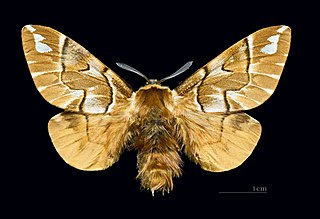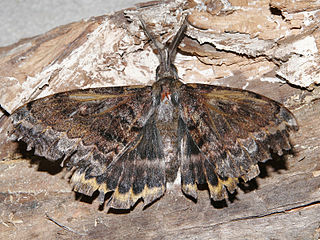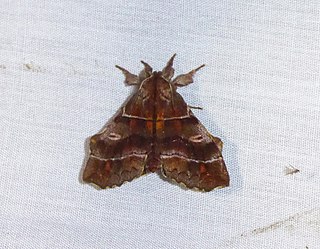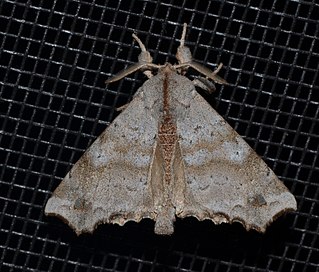180,000 species of Lepidoptera are described, equivalent to 10% of the total described species of living organisms. This is a list of the diversity of the Lepidoptera showing the estimated number of genera and species described for each superfamily and, where available, family. See Lepidoptera for a note of the schedule of families used.

Endromidae is a family of moths consisting of 16 genera with 72 species. This relictual family is related to the families Carthaeidae, Anthelidae, and Phiditiidae as part of the bombycine group “CAPOPEM”.

Anthelidae is a family of Australian lappet moths in the order Lepidoptera. It had earlier been considered to be part of the Lasiocampoidea superfamily, but a 2008 molecular phylogenetic study, supported by a 2011 study, resulted in reincluding the Anthelidae in the superfamily Bombycoidea.

Apatelodidae, the American silkworm moths, is a family of insects in the order Lepidoptera. They are a family within the superfamily Bombycoidea, though they have in the past been considered a subfamily of Bombycidae.
Hydropionea is a genus of moths of the family Crambidae. The 13 described species are distributed in Central and South America.
Druentica inscita is a moth of the family Mimallonidae. It is native to Mexico, and was thought to have been introduced to Hawaii for biological control of Clidemia hirta. However, recent research has suggested that the species introduced to Hawaii was misidentified, and is now known to be Druentica coralie.
Cheneya is a small genus of moths of the family Bombycidae, within which it is placed in subfamily Epiinae.
Ephoria is a genus of moths of the family Apatelodidae. It was previously known as Colabata, as a result of Herrich-Schäffer's Synopsis familiarum Lepidopterorum—in which Ephoria was introduced—having been published twice. The earlier of these publications precedes that of Walker's Colabata in 1856, making the latter the junior synonym.
Drepatelodes is a genus of moths of the family Apatelodidae.

Apatelodes is a genus of moths of the family Apatelodidae first described by Packard in 1864.

Prothysana is a genus of moths of the family Apatelodidae. It contains two species, whose larvae are known as shag-carpet caterpillars. They are found from Mexico, south to Panama and into South America, at least to Ecuador.
Prothysana terminalis is a moth in the family Apatelodidae whose larvae are known as shag-carpet caterpillars. The species was first described by Francis Walker in 1855. It is found in South America.
Thelosia is a genus of moths of the Apatelodidae family. It was first described in 1896 by William Schaus, containing at the time three species: Thelosia phalaena, T. camina and T. truvena. Since then, several additional species have been described.

Zanola is a genus of moths in the family Apatelodidae.
Ephoria liliana is a moth in the Apatelodidae family. It was described by Schaus in 1900. It is found in Brazil (Parana).
Thelosia truncata is a moth in the Apatelodidae family. It was first described by William Schaus in 1894, as Trabala (?) truncata. It is found in Brazil (Parana).

Olceclostera is a genus of moths of the family Apatelodidae.

Lacosoma is a genus of sack-bearer moths in the family Mimallonidae. There are at least 30 described species in Lacosoma.
Lacosoma arizonicum, the southwestern sack-bearer moth, is a species of moth in the family Mimallonidae and one of four species of sack-bearers occurring north of Mexico. Its type locality is the Chiricahua Mountains of Arizona. The species was first described by Harrison Gray Dyar Jr. in 1898 from a single male specimen and has Hodges number 7660.
Pantelodes is a genus of moths of the family Apatelodidae. It was first described by Daniel Herbin in 2017, containing at the time nine species: Pantelodes satellitia and eight newly described species previously identified as the former. In 2021, an additional species, Pantelodes camacana, was described. The distribution of the genus is Neotropical.








